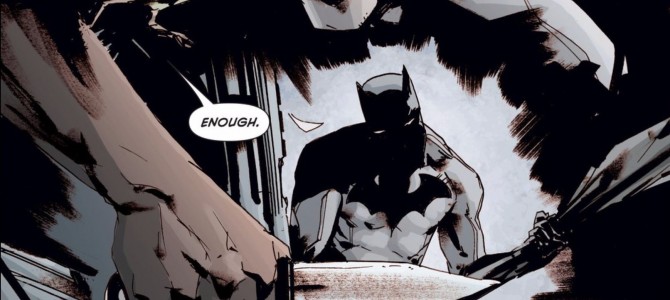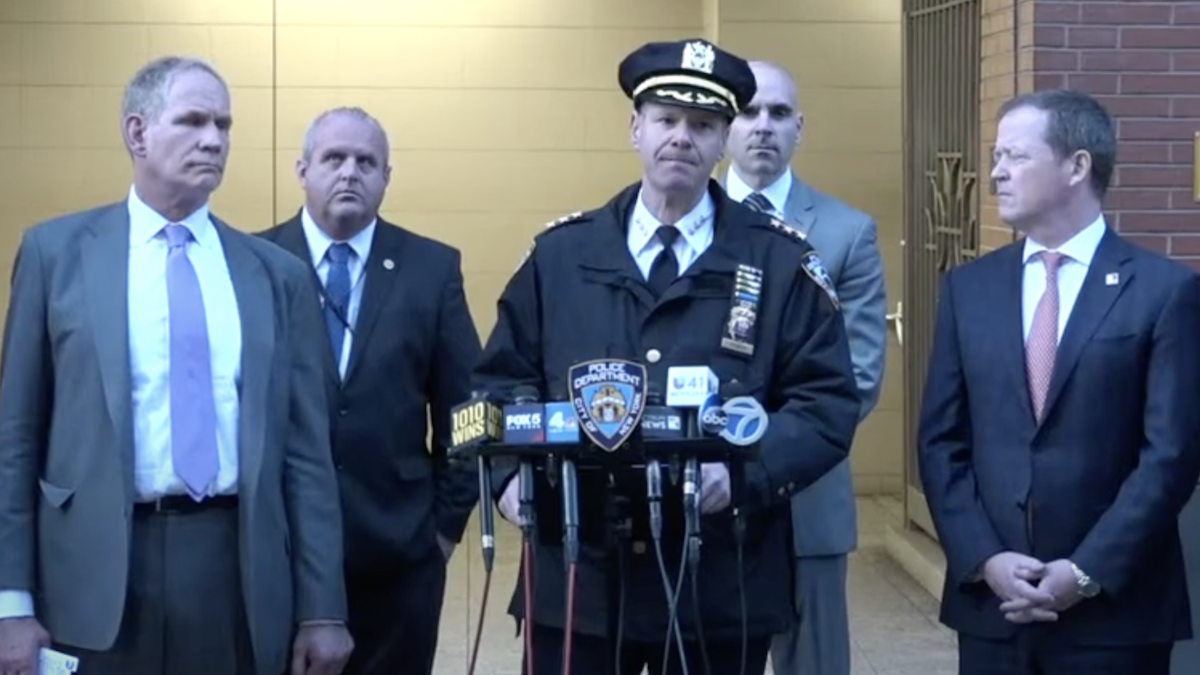
Last fall “Batman #44” hit the comic book stands, and a number of voices, including its authors Scott Snyder and Brian Azzarello, claimed it was an attempt to address the intersection of police brutality and gentrification or, more bluntly, that Batman was confronting institutionalized police racism. Some even noted the story holds “white readers accountable for their complicity in the real-world situations that the comic analogises.” But is that really the case?
The main point of this contention comes from the idea that Gotham City Police Department (GCPD) Officer Ned Howler shot dead a young African-American boy, Peter Duggio. However, Snyder and Azzarello confirm on the third page of the book the boy was not killed by gunfire. In Batman’s own words, “I’d agree if the shots had killed him. But I scanned him. He died from a fall. Dropped here. From about a thousand feet up.”
The book does confirm Howler shot and wounded Duggio, but the context in which the shooting occurs disputes the idea that this issue delves into institutionalized police racism. Instead, this book examines Duggio’s terrible choices and crimes.
It’s Not Clear the Police Were Especially at Fault
The first of those mistakes was turning to the crime-lord Penguin to protect his bodega from Penguin’s rivals, the Four Fives gang. The Four Fives gang had been moving in on the store after Bruce Wayne’s announcement he would redevelop the entire neighborhood where it was located. Penguin accepted Duggio’s deal and took control of the bodega; except, once he took control, he gifted the property to the Four Fives gang to end their feud.
Duggio got in bed with criminals, and he paid the price. However, this didn’t sit well with him. He decided to enact his own vengeance, storming the bodega and picking a fight with the Four Fives, even setting the store ablaze. This gang fight and blaze sent Officer Howler down to the neighborhood to restore order. Upon Ned’s arrival at the fire, Duggio exited the building. Duggio was bent over, one hand on his head; the other was by his waist out of the officer’s sight. Howler asked Duggio to get on the ground twice before he ended up opening fire.
Was Howler right in shooting an arson suspect and supposed gang member who might have been going for a gun? Snyder believes, “You want Batman to beat this officer up, and be like, ‘How could you?’” However, this is not an emotion I experienced at all. I’m not even sure Officer Howler did anything wrong. He ordered an arsonist to get on the ground twice before firing, although his decision to pull the trigger was hasty.
Snyder does acknowledge that continued violence against Howler “wouldn’t solve the problem. Batman throwing the officer off a roof or throwing the officer in jail, it wouldn’t get to the heart of the matter at all.” While I agree that having Batman throw Howler off a roof wouldn’t solve the problem, I find it difficult to comprehend his suggestion about jail time failing to. If individuals commit a crime, they should be punished accordingly, and prison might not be a terrible solution. In this specific case, I do not believe Howler was in the wrong.
This event is also just one specific example of a police officer shooting an African-American. It is hardly cause to be claiming Batman is confronting institutionalized racism or even claiming the GCPD is racist. For one, Howler’s actions are hardly racist. He responded to a crime in progress and shot a suspect who had failed to heed his multiple warnings. The comic does include newspaper clippings hinting at a significant number of officer-involved shootings of black individuals. However, it does not provide any context about the reasons for the shootings.
This ‘Batman’ Doesn’t Rip Gentrification, Either
Now that the myth of Batman confronting police brutality in “Batman #44” has been dispelled, let’s examine the idea that he is also confronting gentrification. He is in fact not confronting it, but could be promoting it. Towards the end of the book, Bruce Wayne announces plans to renovate Duggio’s neighborhood, providing an infusion of capital and creating Wayne Apartments with upscale living conditions.
The idea that Snyder and Azzarello believe gentrification is wrong comes from a newspaper clipping within the book stating, “Wayne Apartments…might drive up property values and force out longtime residents.” However, the article also notes Wayne Apartments will be “designed to provide upscale living conditions for lower-middle class families in the Corner.” Thus, Bruce Wayne and Wayne Enterprises might actually be building these new homes to help the people already living there. It is unclear what the actual process will be to find tenants.
Even if Wayne isn’t aiming at providing better accommodations for the current residents, gentrification isn’t some vile or evil act. Economist Walter Block notes that property owners like Duggio “will have so much money thrust down their throats that they will prefer their new digs to their old ones. Otherwise, they will stay put, and not be ‘run out of town’ by the newcomers.” Unfortunately, Peter chose to make deals with criminals like the Penguin instead of bankers and investors who might be interested in his property.
In the case of renters, opposing gentrification is “an attack on the marketplace.” It would mean that bidding for goods in general is wrong. Block also argues that gentrification does not mean a landlord can keep tenants within his building, restricting their ability to move freely. In a similar argument, one does not have the right to another’s property; landlords are free to do with their property as they will.
Azzarello used his experience with a public housing project in Chicago to influence his ideas on gentrification within the book. The problem is that Chicago and Gotham have two different issues. In Gotham, Bruce Wayne, a private citizen, announces a planned redevelopment using his own finances. In contrast, Chicago turns to the government to alleviate poverty with welfare. The Cato Institute’s Michael Tanner discusses how government welfare leads to increased poverty and how Wayne’s charitable actions are able to “individualize approaches and can target the specific problems that are holding people in poverty.”
In conclusion, Duggio’s own actions bring on the real-world situation analogized in the story. He made his choices, and they involved making deals with criminals, assaulting another individual, and committing arson. “White readers” are not responsible or complicit for the actions another individual takes. “Batman #44” also shows the tough and dangerous position many law enforcement officers face while on the job—not to mention how criminalizing drugs can lead to crime and violence, but that is an article for another day.









